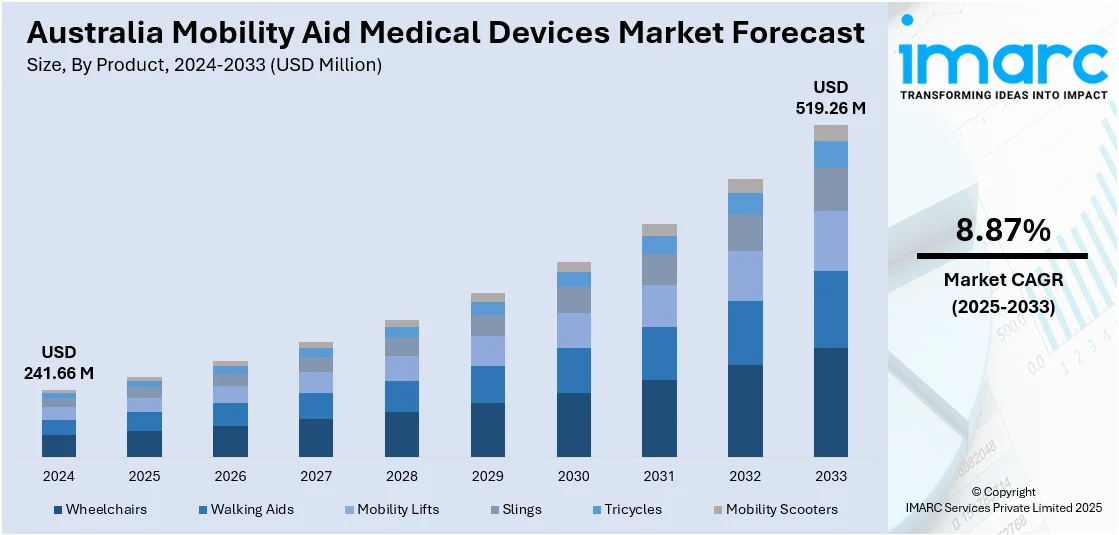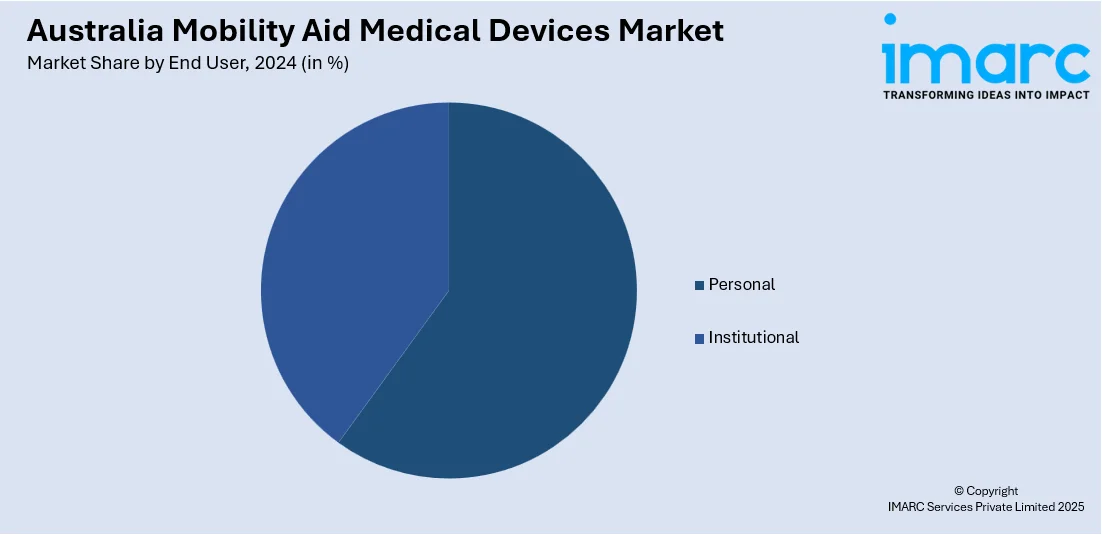
Australia Mobility Aid Medical Devices Market Size, Share, Trends and Forecast by Product, End User, and Region, 2025-2033
Australia Mobility Aid Medical Devices Market Overview:
The Australia mobility aid medical devices market size reached USD 241.66 Million in 2024. Looking forward, IMARC Group expects the market to reach USD 519.26 Million by 2033, exhibiting a growth rate (CAGR) of 8.87% during 2025-2033. The market is experiencing growth driven by the increasing elderly population and demand for home healthcare solutions. Moreover, technological advancements in mobility devices and government reforms are also supporting the industry, contributing to the expansion of Australia mobility aid medical devices market share across various segments.
|
Report Attribute
|
Key Statistics
|
|---|---|
|
Base Year
|
2024
|
|
Forecast Years
|
2025-2033
|
|
Historical Years
|
2019-2024
|
| Market Size in 2024 | USD 241.66 Million |
| Market Forecast in 2033 | USD 519.26 Million |
| Market Growth Rate 2025-2033 | 8.87% |
Australia Mobility Aid Medical Devices Market Trends:
Increasing Demand for Home Healthcare Solutions
The Australia mobility aid medical devices market growth has been propelled largely by the increasing need for home healthcare products. With the aging population, most Australians would rather get treated in the comforts of their homes and not in the usual healthcare centers. This has increased the demand for mobility aids such as wheelchairs, walking aids, and lifting devices. The emphasis on enhancing the well-being of aged people and people with disabilities has led to more product development that aims to promote independence and comfort within the home. Technologies like lightweight, user-friendly mobility aids and intelligent technologies have fueled this demand. Further, the government's efforts towards encouraging aged care reforms and the provision of funding for in-home care have benefited the market. Firms are further directing attention towards developing mobility aids not just for function but also for suitability to home settings, providing convenience, safety, and efficiency. The trend is likely to keep gaining momentum as more Australians choose home care, fueling the growth of the mobility aid medical devices market across the country.

To get more information on this market, Request Sample
Technological Advancements in Mobility Devices
The market is majorly influenced by the rapid technological advancements in mobility products. The incorporation of smart technologies into traditional mobility aids has revolutionized the market. For example, powered wheelchairs now feature improved battery life, intuitive control systems, and remote monitoring options. These devices are becoming increasingly user-friendly, enabling individuals to customize settings according to their personal preferences and needs. The integration of sensors and real-time data tracking enhances user experience by providing more accurate feedback, improving safety, and increasing efficiency. Furthermore, advancements in materials have resulted in lighter, more durable devices, making them easier to use and transport. The rise of artificial intelligence and robotics also holds promise for the future of mobility aids, offering potential solutions like self-driving wheelchairs and assistive robots for elderly care. This growing interest in technological innovation is likely to drive the development of next-generation mobility aids, ensuring that users benefit from enhanced mobility, independence, and overall well-being in their daily lives.
Australia Mobility Aid Medical Devices Market Segmentation:
IMARC Group provides an analysis of the key trends in each segment of the market, along with forecasts at the country and regional level for 2025-2033. Our report has categorized the market based on product and end user.
Product Insights:
- Wheelchairs
- Walking Aids
- Mobility Lifts
- Slings
- Tricycles
- Mobility Scooters
The report has provided a detailed breakup and analysis of the market based on the product. This includes wheelchairs, walking aids, mobility lifts, slings, tricycles, and mobility scooters.
End User Insights:

- Personal
- Institutional
The report has provided a detailed breakup and analysis of the market based on the end user. This includes personal and institutional.
Regional Insights:
- Australia Capital Territory & New South Wales
- Victoria & Tasmania
- Queensland
- Northern Territory & Southern Australia
- Western Australia
The report has also provided a comprehensive analysis of all the major regional markets, which include Australia Capital Territory & New South Wales, Victoria & Tasmania, Queensland, Northern Territory & Southern Australia, and Western Australia.
Competitive Landscape:
The market research report has also provided a comprehensive analysis of the competitive landscape. Competitive analysis such as market structure, key player positioning, top winning strategies, competitive dashboard, and company evaluation quadrant has been covered in the report. Also, detailed profiles of all major companies have been provided.
Australia Mobility Aid Medical Devices Market News:
- April 2025: Sunrise Medical introduced the Empulse F35, a lightweight power assist device designed for urban mobility. Its compact design, smooth performance, and airline-friendly features significantly impacted the mobility aid medical devices market, enhancing independence and convenience for users, while driving innovation in portable solutions.
- August 2024: Arjo opened a larger reprocessing facility to enhance production and customer service. This expansion aimed to meet rising demand for mobility aid solutions, improving turnaround times and supporting sustainability goals, further solidifying Arjo's position in the global mobility aid medical devices market.
Australia Mobility Aid Medical Devices Market Report Coverage:
| Report Features | Details |
|---|---|
| Base Year of the Analysis | 2024 |
| Historical Period | 2019-2024 |
| Forecast Period | 2025-2033 |
| Units | Million USD |
| Scope of the Report |
Exploration of Historical Trends and Market Outlook, Industry Catalysts and Challenges, Segment-Wise Historical and Future Market Assessment:
|
| Products Covered | Wheelchairs, Walking Aids, Mobility Lifts, Slings, Tricycles, Mobility Scooters |
| End Users Covered | Personal, Institutional |
| Regions Covered | Australia Capital Territory & New South Wales, Victoria & Tasmania, Queensland, Northern Territory & Southern Australia, Western Australia |
| Customization Scope | 10% Free Customization |
| Post-Sale Analyst Support | 10-12 Weeks |
| Delivery Format | PDF and Excel through Email (We can also provide the editable version of the report in PPT/Word format on special request) |
Key Questions Answered in This Report:
- How has the Australia mobility aid medical devices market performed so far and how will it perform in the coming years?
- What is the breakup of the Australia mobility aid medical devices market on the basis of product?
- What is the breakup of the Australia mobility aid medical devices market on the basis of end user?
- What is the breakup of the Australia mobility aid medical devices market on the basis of region?
- What are the various stages in the value chain of the Australia mobility aid medical devices market?
- What are the key driving factors and challenges in the Australia mobility aid medical devices market?
- What is the structure of the Australia mobility aid medical devices market and who are the key players?
- What is the degree of competition in the Australia mobility aid medical devices market?
Key Benefits for Stakeholders:
- IMARC’s industry report offers a comprehensive quantitative analysis of various market segments, historical and current market trends, market forecasts, and dynamics of the Australia mobility aid medical devices market from 2019-2033.
- The research report provides the latest information on the market drivers, challenges, and opportunities in the Australia mobility aid medical devices market.
- Porter's five forces analysis assist stakeholders in assessing the impact of new entrants, competitive rivalry, supplier power, buyer power, and the threat of substitution. It helps stakeholders to analyze the level of competition within the Australia mobility aid medical devices industry and its attractiveness.
- Competitive landscape allows stakeholders to understand their competitive environment and provides an insight into the current positions of key players in the market.
Need more help?
- Speak to our experienced analysts for insights on the current market scenarios.
- Include additional segments and countries to customize the report as per your requirement.
- Gain an unparalleled competitive advantage in your domain by understanding how to utilize the report and positively impacting your operations and revenue.
- For further assistance, please connect with our analysts.
 Request Customization
Request Customization
 Speak to an Analyst
Speak to an Analyst
 Request Brochure
Request Brochure
 Inquire Before Buying
Inquire Before Buying




.webp)




.webp)












